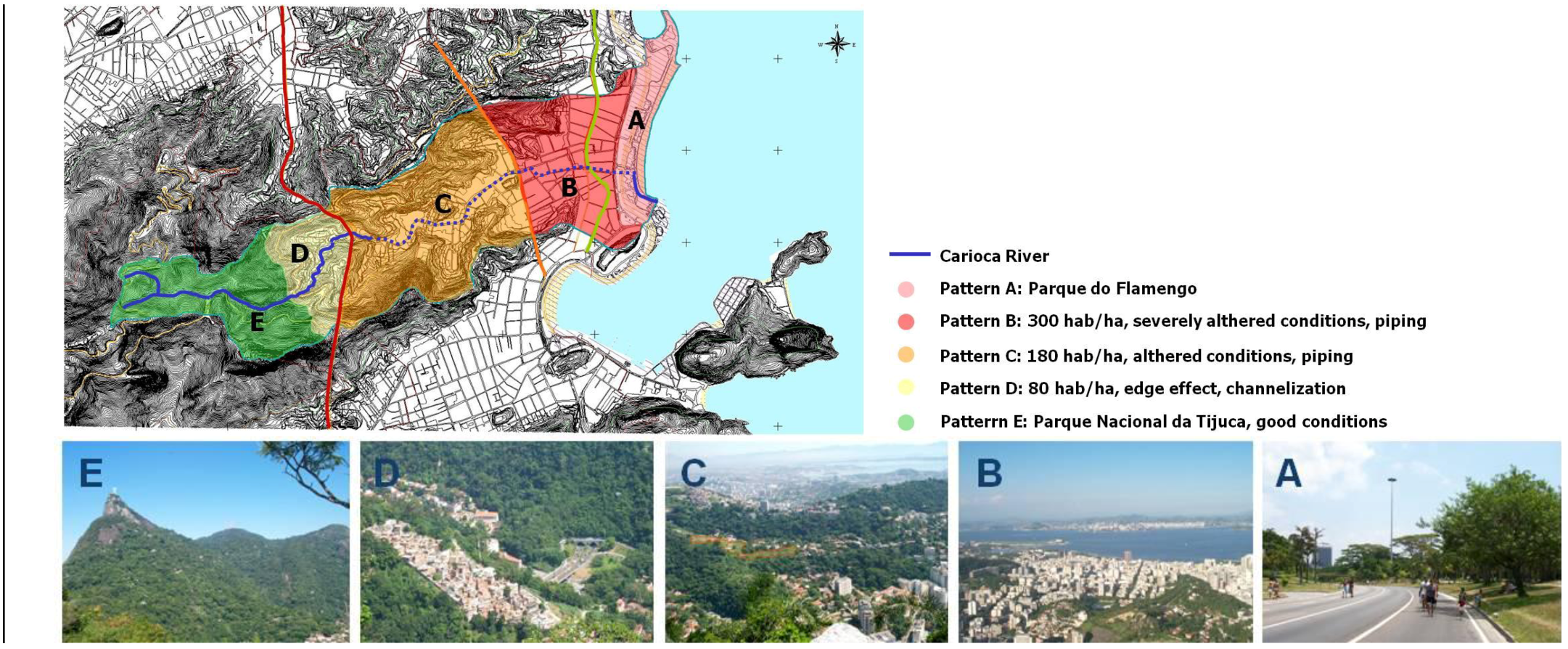A Method for Gauging Landscape Change as a Prelude to Urban Watershed Regeneration: The Case of the Carioca River, Rio de Janeiro
Abstract
:1. Introduction

- ■ Enhance and strengthen environmental awareness among urban decision-makers and inhabitants;
- ■ Acknowledge human and environmental connectivity;
- ■ Strive for cultural and social cohesiveness towards sustainability;
- ■ Focus on the source, not on the resource;
- ■ Assure public participation in all the planning and management phases.
2. Methods
2.1. Methods Applied in Research Phase 1 (2000–2002)
- ■ historical analyses (research at local archives and GIS mapping, correlating past and current conditions);
- ■ comparison with reference rivers that function as parameters of quality and are located in the same geographic region as the Carioca (Atlantic Rainforest biome);
- ■ identification of main environmental impacts that affect the watershed under study;
- ■ biochemical and biological on-site assessments of water quality;
- ■ development of a hybrid protocol more attuned to neotropical urban streams (the Neotropical Urban Stream Visual Assessment Protocol—NUSVAP), using local ecological indicators of water quality and rainforest integrity;
- ■ GIS mapping of landscape ecology, biological and urban parameters at 1:10,000 scale: geomorphology, water quality, land use and vegetation cover evolution (1972, 1984 and 1999) [39], population dynamics [40,41], occurrence of edge effects, and a synthesis of environmental patterns collectively organized along a longitudinal profile of the Carioca.
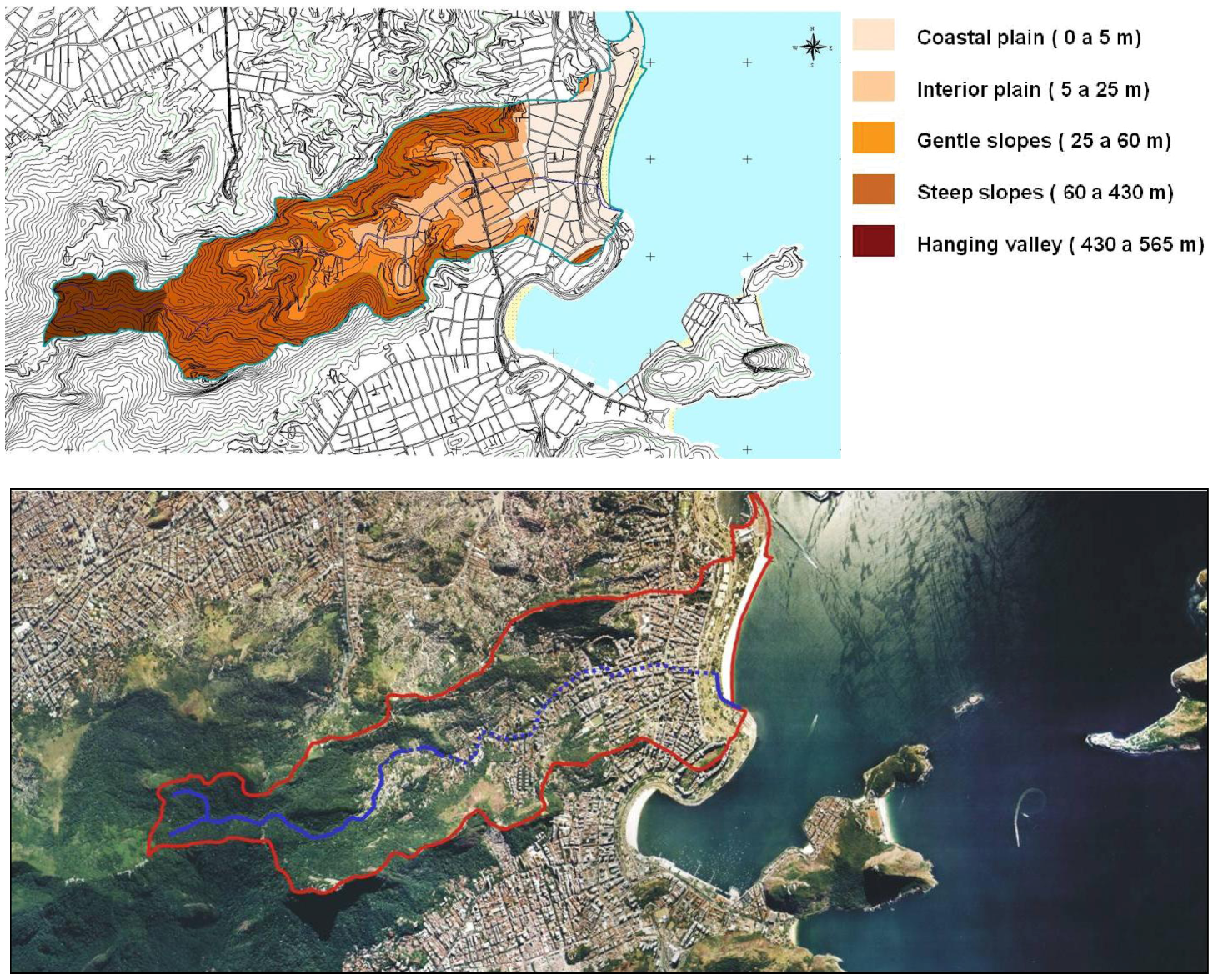
- ■ Mountain rainforest (Tijuca National Park)
- ■ Favela (Guararapes community)
- ■ High-income residential area (upper Cosme Velho district)
- ■ Coastal plain (Flamengo Park situated on the filled Guanabara Bay shore)
- ■ Impact type: urban vs. agricultural;
- ■ Broad environmental region: tropical vs. temperate;
- ■ Landscape position: mountains vs. plains;
- ■ Urban infrastructure: presence of domestic sewage along the river path versus sewage treatment along the river path.
- ■ broad landscape conditions: land use and channel conditions;
- ■ water conditions: hydrologic alteration, occurrence of sewage discharge and manure presence, aquatic vegetation/nutrient enrichment, occurrence of solid waste disposal, presence of toxicant substances;
- ■ riparian vegetation conditions: riparian zone, canopy cover, composition of riparian vegetation within 10 meters of the channel;
- ■ morphological components: riffles and pools, meanders, pool conditions, barriers to fish movement, retention devices, stream-bank structure, bank undercutting, stream bottom, stony substrate conditions, channel sediment deposition/riffle embeddedness;
- ■ habitat conditions: in-stream fish cover, insect/invertebrate habitat, detritus; and
- ■ aquatic biota presence: macro-invertebrates observed.
| 1. Land use pattern beyond the immediate riparian zone | |||||||||||||||||||||||
| Undisturbed original ecosystem, consisting of forests, wetlands, or coastal ecosystem vegetation ( restingas and mangroves). Presence of walking trails. | Preserved forests, wetlands, or coastal ecosystem vegetation ( restingas and mangroves) with access for visitors. Presence of roads and/or railroads. | Residential use with adequate infrastructure (including sewage system) with patches of original ecosystem vegetation still present. Grasses, banana plantations or sparse occurrence of crops with signs of pesticide use. | Residential or mixed use (residential, commercial, industrial) with inadequate or damaged infrastructure. Eucalyptus plantations and sparse occurrence of exotic grasses or crops with signs of pesticide use. Livestock raising (chickens, pigs, and cattle) mixed with row crops within the immediate riparian zone. | Widespread occurrence of exotic grasses or crops with signs of pesticide use. Residential or mixed use (residential, commercial, industrial) without any infrastructure. | |||||||||||||||||||
| 10 | 9 | 8 | 7 | 6 | 5 | 4 | 3 | 2 | 1 | ||||||||||||||
| 2. Channel condition | |||||||||||||||||||||||
| Natural channel. No structures or dikes. No evidence of downcutting or excessive lateral cutting. No signs of disturbance caused by free access to the stream. | Evidence of past channel alteration, but with significant recovery of channel and banks. Any dikes or levies are set back to provide access to an adequate flood plain. Human/animal activity causing minor disturbances. | Altered channel. <50% of the reach with riprap and/or channelization. Excess aggradation, braided channel. Dikes or levees restrict flood plain width. Intense human/animal activity causing considerable disturbances. | Channel is actively down cutting or widening. >50% of the reach with riprap or channelization. Dikes or levees prevent access to the flood plain. Visual access to the stream still preserved. | River buried underground. No access to the river is possible. | |||||||||||||||||||
| 10 | 9 | 8 | 7 | 6 | 5 | 4 | 3 | 2 | 1 | ||||||||||||||
| 3. Hydrologic alteration | |||||||||||||||||||||||
| No dams, no water withdrawals, no dikes or other structures affecting flow regime or limiting the stream access to the floodplain. | Withdrawals, although present, do not affect flow regime and/or available habitat for biota. | Withdrawals significantly affect flow regime and/or available habitat for biota. | Withdrawals, channelization or piping have caused complete alteration of flow regime and severe loss of habitat, severely affecting aquatic biota. | ||||||||||||||||||||
| 10 | 9 | 8 | 7 | 6 | 5 | 4 | 3 | 2 | 1 | ||||||||||||||
| 4. Occurrence of sewage discharge and presence of manure | |||||||||||||||||||||||
| No wastewater or stormwater discharge. Clear water along the entire reach. No sewage odor. | Stormwater discharge. Fairly clear or occasional slightly greenish water at sparse points of reach. Sporadic occurrence of sewage odor. | Occasional clandestine wastewater discharge. Greenish to pea green water along entire reach. Weak but constant sewage odor. Occasional manure in stream banks. | Constant wastewater discharge. Gray or brown water along entire reach. Occurrence of surface scum, sheen or heavy coat of foam on water surface. Strong and constant sewage odor. Frequent manure on banks or in stream. | ||||||||||||||||||||
| 10 | 9 | 8 | 7 | 6 | 5 | 4 | 3 | 2 | 1 | ||||||||||||||
| 5. Aquatic vegetation/Nutrient enrichment | |||||||||||||||||||||||
| Presence of aquatic plant community in moderate amounts. Mosses and small patches of algae present. | Algal growth on stream substrates, few mosses. Aquatic plants along margins. | Sparse occurrence of mosses and overabundance of aquatic plants. Algal blooms clogging stream, especially during warmer months. | Aquatic vegetation absent. | ||||||||||||||||||||
| 10 | 9 | 8 | 7 | 6 | 5 | 4 | 3 | 2 | 1 | ||||||||||||||
| 6. Occurrence of solid waste disposal | |||||||||||||||||||||||
| No solid waste disposal observed in the entire reach. | Occasional and sparse presence of organic waste, such as food remains, wood and paper. | Constant solid waste disposal in small amounts on stream banks and streambed along reach—plastic bags, cups, bottles, etc. | Constant solid waste disposal on streambed and banks clogs stream channel and aggravates flooding events. | ||||||||||||||||||||
| 10 | 9 | 8 | 7 | 6 | 5 | 4 | 3 | 2 | 1 | ||||||||||||||
| 7. Presence of toxicant substances (scum, oil, odor) | |||||||||||||||||||||||
| No noticeable oil film or other toxicant substances. | Sparse and occasional occurrence of oil sheen on water surface. | Frequent occurrence of oil sheen, and surface scum on water surface. | Continuous occurrence of oil sheen, surface scum, sheen or heavy coat of foam on water surface. Strong odor of chemicals, oil or other pollutants. | ||||||||||||||||||||
| 10 | 9 | 8 | 7 | 6 | 5 | 4 | 3 | 2 | 1 | ||||||||||||||
| 8. Riparian zone | |||||||||||||||||||||||
| Natural vegetation (trees, shrubs, and ground species) is > 50 meters wide. No breaks in vegetation, no paved, dirt or railroads present. | Natural vegetation ranges from 15 to 50 meters wide. Paved, dirt or railroads present. Sparse occurrence of breaks on vegetation along entire reach. | Natural vegetation ranges from 5 to 15 meters wide. Breaks occurring at intervals of >50 meters. Signs of natural regeneration. Paved, dirt or railroads adjacent to the river’s riparian zone. | Natural or planted vegetation ranges from 1 to 5 meters wide. Breaks frequent with some gullies and scars within intervals of 50 meters. No signs of natural regeneration. Introduced vegetation provides some shade. | Vegetation absent. Deeply scarred with gullies along its length. Filtering function and aquatic biota severely compromised. | |||||||||||||||||||
| 10 | 9 | 8 | 7 | 6 | 5 | 4 | 3 | 2 | 1 | ||||||||||||||
| 9. Canopy cover (for streams from first to third order) | |||||||||||||||||||||||
| >80% of water surface shaded. Upstream generally well shaded. | From 50% to 80% of water surface in reach shaded but upstream poorly shaded. | 20 to 50% of water surface in reach shaded. | <20% of water surface in reach shaded. | ||||||||||||||||||||
| 10 | 9 | 8 | 7 | 6 | 5 | 4 | 3 | 2 | 1 | ||||||||||||||
| 10. Composition of riparian vegetation | |||||||||||||||||||||||
| High density of all strata, including native and non-pioneer high trees, understory trees, shrubs, and herbaceous plants. Continuous and regular texture of canopy cover. High density of epiphytic species. | Mixed climax species and late secondary trees, such as jacatirão, canela-preta, and pau-jacaré along channel. One of the strata may be not well represented. Occasional occurrence of exotic but well adapted tree species, such as jaqueira. Coarse texture of canopy cover. | Mixed grasses and sparse pioneer trees, such as green embaúba, and quaresmeira and/or shrub species. Presence of native (but non-local) and exotic tree species. | Vegetation consisting of exotic grasses, such as capim colonião and capim gordura and few shrubs, such as cambarás. Sparse exotic tree species. | ||||||||||||||||||||
| 10 | 9 | 8 | 7 | 6 | 5 | 4 | 3 | 2 | 1 | ||||||||||||||
| 11. Riffles and pools, or meanders | |||||||||||||||||||||||
| Distinct, occurring within regular intervals. Occurrence of riffles relatively frequent. Placement of boulders provides “naturally constructed” meanders. | Irregularly spaced. Occurrence of riffles and meanders infrequent. | Long pools separating short and sparse riffles, meanders absent. Although channelized, streambed conserves natural condition. | Generally all flat water. Meanders, riffles and pools absent. Artificial streambed and banks. | ||||||||||||||||||||
| 10 | 9 | 8 | 7 | 6 | 5 | 4 | 3 | 2 | 1 | ||||||||||||||
| 12. Pools | |||||||||||||||||||||||
| Deep and shallow pools abundant, with a mix of substrate materials. | Pools present, but shallow and not abundant. | Shallow pools with the entire bottom discernible. Presence of only one type (fine) substrate material. | Pools absent. | ||||||||||||||||||||
| 10 | 9 | 8 | 7 | 6 | 5 | 4 | 3 | 2 | 1 | ||||||||||||||
| 13. Barriers to fish movement | |||||||||||||||||||||||
| No artificial barriers. | Seasonal water withdrawals inhibit movement within the reach. | Drop structures, culverts, dams or diversions (>0.30 meters/1 foot drop) within 5 kms downstream of the reach. | Drop structures, culverts, dams, or diversions (>0.30 meters/1 foot drop) within or upstream the reach. | ||||||||||||||||||||
| 10 | 9 | 8 | 7 | 6 | 5 | 4 | 3 | 2 | 1 | ||||||||||||||
| 14. Natural retention devices | |||||||||||||||||||||||
| Channel with rocks, old logs and snags firmly set in place. | Rocks, old logs and snags present, but 1/3 filled with sediment. | Natural retention devices loose, moving with floods. | Few or no natural retention devices. | ||||||||||||||||||||
| 10 | 9 | 8 | 7 | 6 | 5 | 4 | 3 | 2 | 1 | ||||||||||||||
| 15. Stream bank structure | |||||||||||||||||||||||
| Banks stable; rock and soil held firmly by ground vegetation, shrubs and tree roots. >33% of eroding surface area of banks in outside bends is protected by roots that extend to the base-flow elevation. | Banks moderately stable, but loosely held by ground vegetation, shrubs and tree roots. <33% of eroding surface of banks in outside bends is protected by roots that extend to the base-flow elevation. | Banks unstable, comprised of loose soil held by sparse shrubs and herbaceous vegetation. Outside bends are actively eroding (slope failures apparent). | Straight reaches, inside and outside edges of bends actively eroding (numerous mature trees falling into stream and numerous slope failures apparent) or banks artificially constructed in concrete or stone revetment along entire reach. | ||||||||||||||||||||
| 10 | 9 | 8 | 7 | 6 | 5 | 4 | 3 | 2 | 1 | ||||||||||||||
| 16. Bank undercutting | |||||||||||||||||||||||
| Little or no evidence or restricted to areas with tree root support. | Cutting only on curves and at constrictions. | Cutting frequent. Undercutting of banks and roots. | Severe cutting along channel. Banks falling in. Artificial banks falling in. | ||||||||||||||||||||
| 10 | 9 | 8 | 7 | 6 | 5 | 4 | 3 | 2 | 1 | ||||||||||||||
| 17. Stream bottom | |||||||||||||||||||||||
| Stony bottom of several sizes packed together and stable in place. Interstices obvious. | Stony bottom of several sizes fairly stable in place. Sand and little silt loosely moving with flow. | Bottom of gravel, sand, silt, and/or clay easily moving. | Uniform bottom of sand-clay loosely held together or moving with the flow. Stony substrate scarce or absent. | ||||||||||||||||||||
| 10 | 9 | 8 | 7 | 6 | 5 | 4 | 3 | 2 | 1 | ||||||||||||||
| 18. Stony substrate feel and appearance | |||||||||||||||||||||||
| Rounded and/or sharp-edged stones (boulders and cobbles), at times covered with mosses. | Small amount of rounded and/or sharp edged stones within slight sandy matrix. | Sparse and sporadic occurrence of sharp-edged stones within chunks of sandy-clayey matrix. | Bright and sharp-edged stones. Rocks not deeply embedded with black undersides—indicators of low dissolved oxygen or anaerobic conditions. Large amounts of non-stratified soil matrix falling into streambed common. | ||||||||||||||||||||
| 10 | 9 | 8 | 7 | 6 | 5 | 4 | 3 | 2 | 1 | ||||||||||||||
| 19. Channel sediment deposition/ Riffle embeddedness | |||||||||||||||||||||||
| Little or no channel enlargement resulting from sediment accumulation. Gravel or cobble particles are <20% embedded. | Sparse occurrence of coarse stones and well-washed debris present. Little fine matrix. Gravel or cobble particles are 20 to 30% embedded. | Sediment bars or clusters of sand and silt common. Gravel or cobble particles are 30 to 50% embedded. | Sediment deposition at obstructions, constrictions and bends. Deposition on pools prevalent. Gravel or cobble particles are 50 to 75% embedded. | Channel divided into braids. Riffle completely embedded. Stream buried underground. | |||||||||||||||||||
| 10 | 9 | 8 | 7 | 6 | 5 | 4 | 3 | 2 | 1 | ||||||||||||||
| 20. In-stream fish cover presence | |||||||||||||||||||||||
| >7 cover types | 6 to 7 cover types | 4 to 5 cover types | 2 to 3 cover types | None to 1 cover type | |||||||||||||||||||
| 10 | 9 | 8 | 7 | 6 | 5 | 4 | 3 | 2 | 1 | ||||||||||||||
| Cover types: logs/large woody debris, deep pools, overhanging vegetation, boulders/cobble, riffles, undercut banks, thick root mats, dense macrophyte beds, isolated/backwater pools, other. | |||||||||||||||||||||||
| 21. Insect/invertebrate habitat | |||||||||||||||||||||||
| At least 5 types of habitat available. Habitat is at a stage to allow full inset colonization (woody debris and logs not freshly fallen). | 3 to 4 types of habitat. Some potential habitat exists, such as overhanging trees that provide habitat but have not yet entered the stream. | 1 to 2 types of habitat. The substrate is often disturbed, covered, or removed by high stream velocities and scour or by sediment deposition. | Zero to 1 type of habitat. Original substrate completely altered. | ||||||||||||||||||||
| 10 | 9 | 8 | 7 | 6 | 5 | 4 | 3 | 2 | 1 | ||||||||||||||
| Cover types: Fine woody debris, submerged logs, leaf packs, undercut banks, cobble and boulders covered by mosses, and coarse gravel. Other: | |||||||||||||||||||||||
| 22. Woody debris and organic detritus | |||||||||||||||||||||||
| Abundant, mainly consisting of leaves and coarse woody debris within small amounts of sediment. | Leaves and woody debris present but not abundant. Coarse and fine organic matter without sediment. | None; scarce leaves or woody debris, coarse and/or fine organic matter with sediment. | Fine anaerobic sediment, no coarse natural debris. | ||||||||||||||||||||
| 10 | 9 | 8 | 7 | 6 | 5 | 4 | 3 | 2 | 1 | ||||||||||||||
| 23. Macro-invertebrates observed | |||||||||||||||||||||||
| Community dominated by Group I (pollution intolerant) species with good species diversity. Examples include water penny larvae, dobsonfly larvae, non-net spinning caddis flies, mayflies, stoneflies, and hellgrammites. | Community dominated by Group II (facultative) species such as damselflies, dragonflies, aquatic sowbugs, net-spinning caddis flies, beetle larvae, and crane flies. | Community dominated by Group III (pollution tolerant) species such as midge flies, black flies, leeches, aquatic earthworms, tubificid worms, and melanoides (exotic snail). | Extremely reduced number of species or near absence of all macro-invertebrates. | ||||||||||||||||||||
| 15 | 6 | 2 | −3 | ||||||||||||||||||||
| Overall score (total divided by number of elements scored) | |||||||||||||||||||||||
| Recommended action | |||||||||||||||||||||||
| Biophysical monitoring for protection of existing conditions. | |||||||||||||||||||||||
| Selected ecological/biological and morphological re-establishment (soil, planting and aquatic biota restoration and reintroduction) and constant biophysical monitoring for changes. | |||||||||||||||||||||||
| Major morphological reestablishment and ecological restoration needed (slope profile, vegetation cover, aquatic biota and water restoration); establishment of community-based restoration programs. | |||||||||||||||||||||||
| Complete structural reorganization and ecological restoration, where possible; programs to increase community awareness of losses and invite participatory restoration. | |||||||||||||||||||||||
2.2. Methods Applied in Research Phase 2 (2007–2011)
- ■ Landscape morphology;
- ■ Processes and agents of formation and transformation;
- ■ Influences of regulatory ordinances.
- 1. Carioca River watershed, on the eastern slopes of Tijuca Massif;
- 2. Confluence of the Rainha watershed and the São Conrado watershed, on the South slopes of the Tijuca Massif;
- 3. Cachoeira River watershed, on the western slopes of the Tijuca Massif.
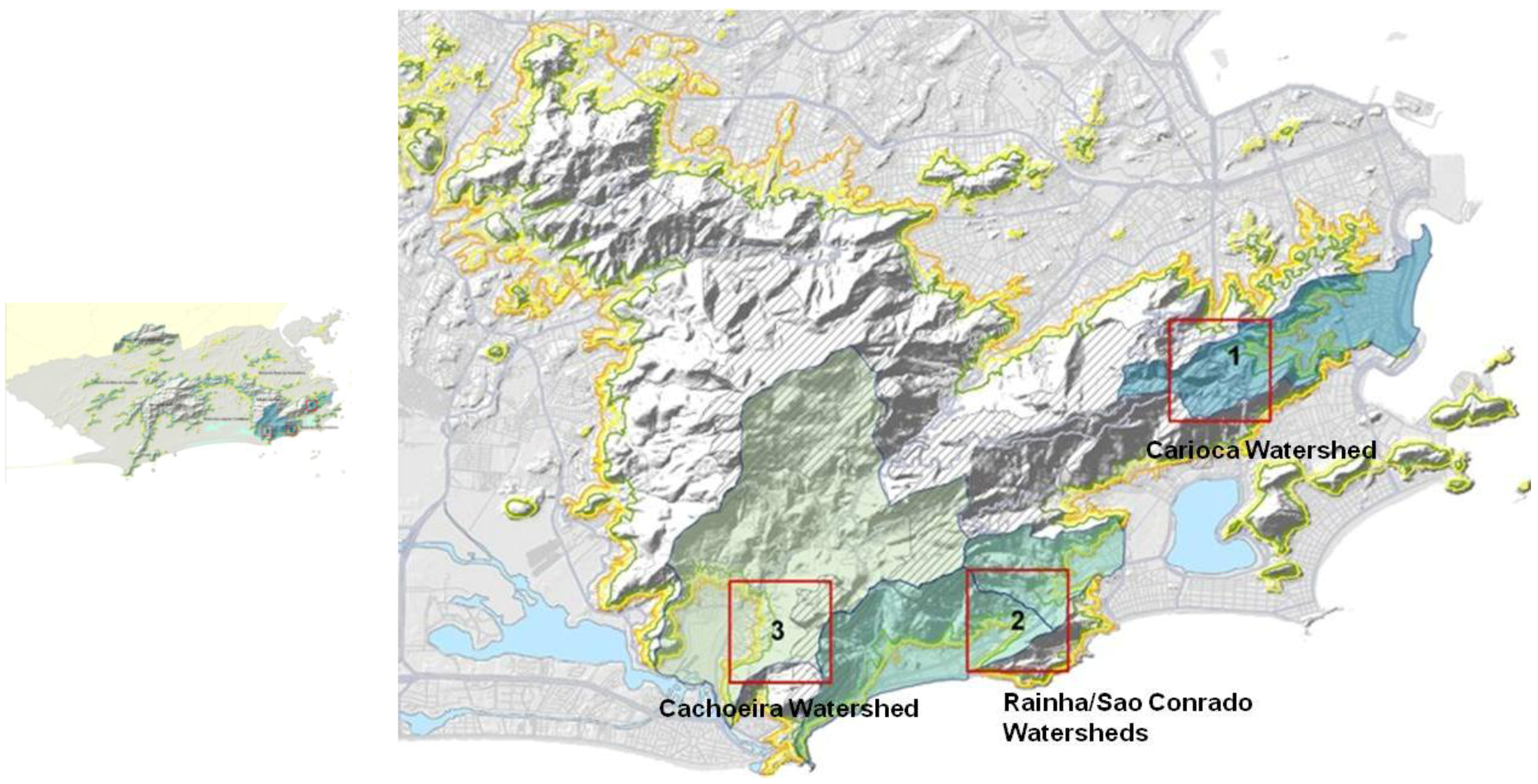
- ■ Environmental characteristics: landscape domains; regional and local geomorphology; biomes; altimetry; percentage of urban land in mountainous areas; predominant vegetation communities; watershed characteristics; slope and slope form (horizontal and vertical curvatures);
- ■ Social characteristics: Rio’s population dynamics [40,41]; population dynamics on the slopes (Observatorio das Metropoles) [50]; density (inhabitants/km2); building density; GDP per capita; incidence of poverty [51]; Urbanization characteristics: land area; genesis and processes of formation and transformation (beginning of formal and favela occupation); location/position of formal settlements and favelas; vectors of occupation; structure of the occupation; current land uses and past land uses; degrees of illegality; land parceling; architectural types; open spaces characteristics;
- ■ Examination of current and past legislation: land use regulation; environmental protection regulation; zoning.
3.1. Assessments and Findings of Research Phase 1 (2000–2002)
3.1.1. Biochemical Assessment
3.1.2. Using Macro-Invertebrates as Bio-Indicators of Stream Health
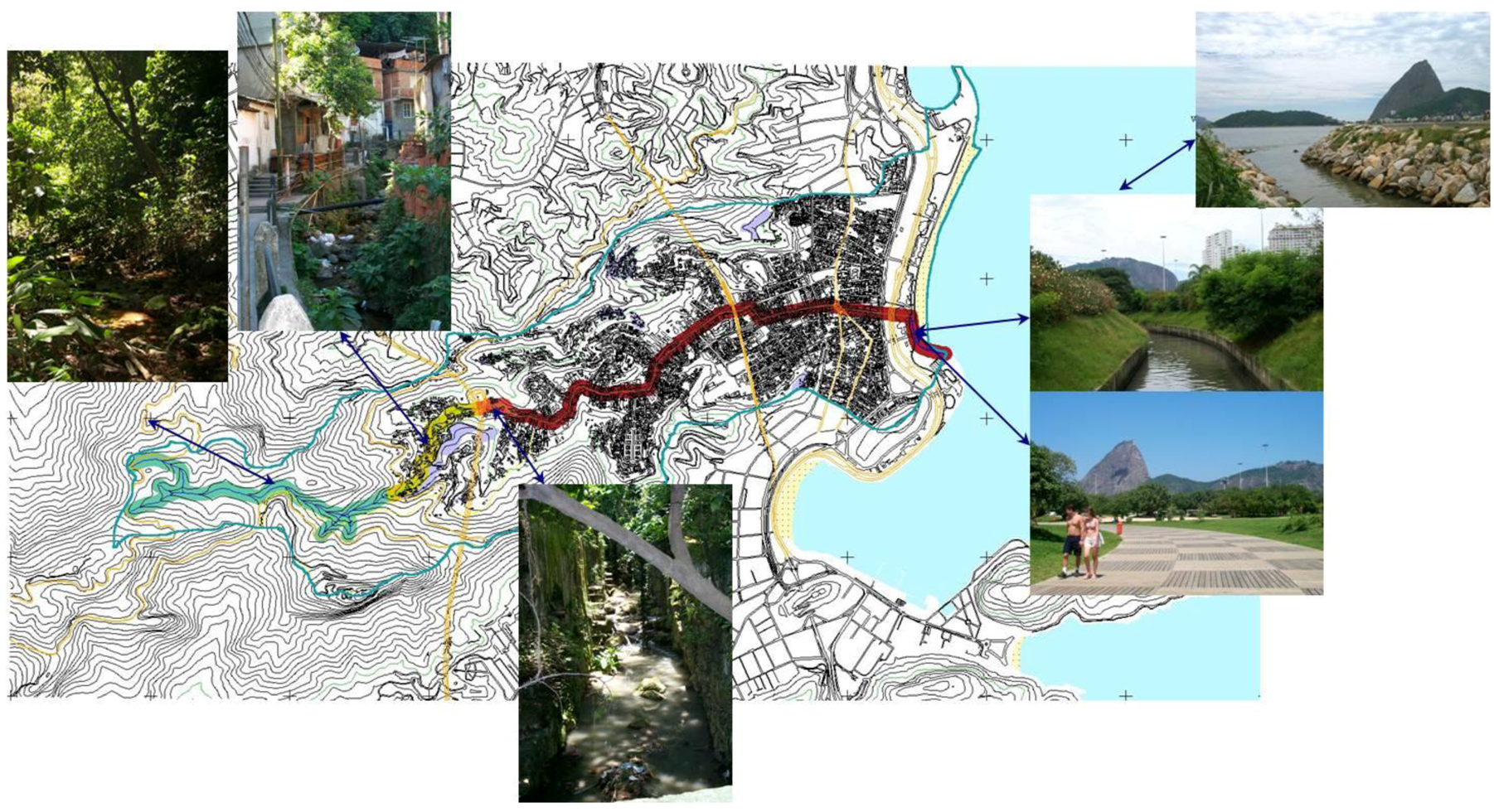
3.1.3. Other Bio-Physical Parameters of Landscape Change
3.1.3.1. Land Cover
3.1.3.2. Population Dynamics
3.1.3.3. Ecological Edge Effect
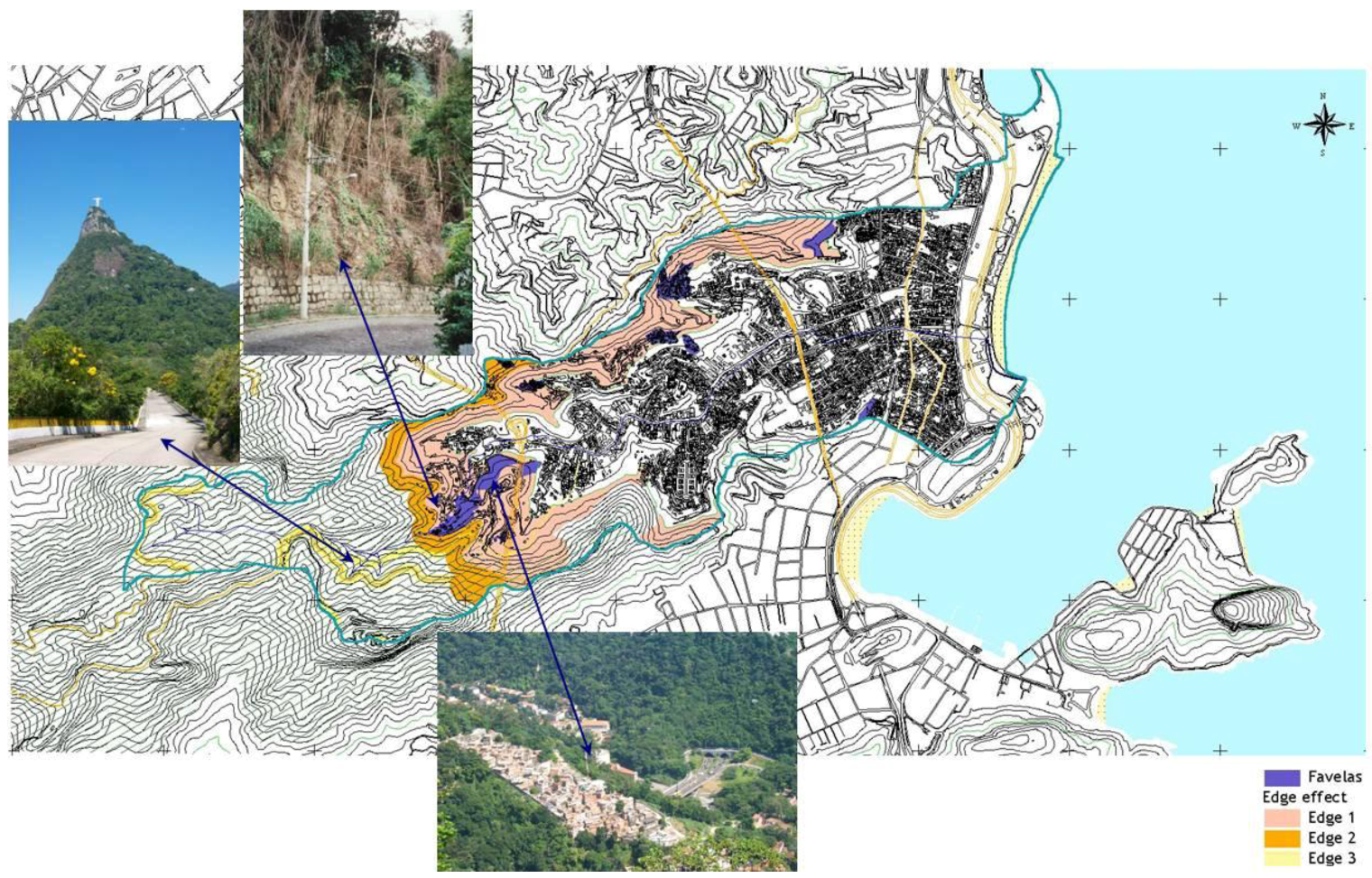

3.2. Assessments and Findings of Research Phase 2 (2007–2011)
3.2.1. Landscape Dynamics: Links between the Current and Past Landscape Configurations
3.2.2. Current Landscape Configuration Patterns
3.2.2.1. Land Ownership

3.2.2.2. Parceling

3.2.2.3. Architectural Types and Height of Built Form
3.2.2.4. Land Use
3.2.2.5. Open Spaces
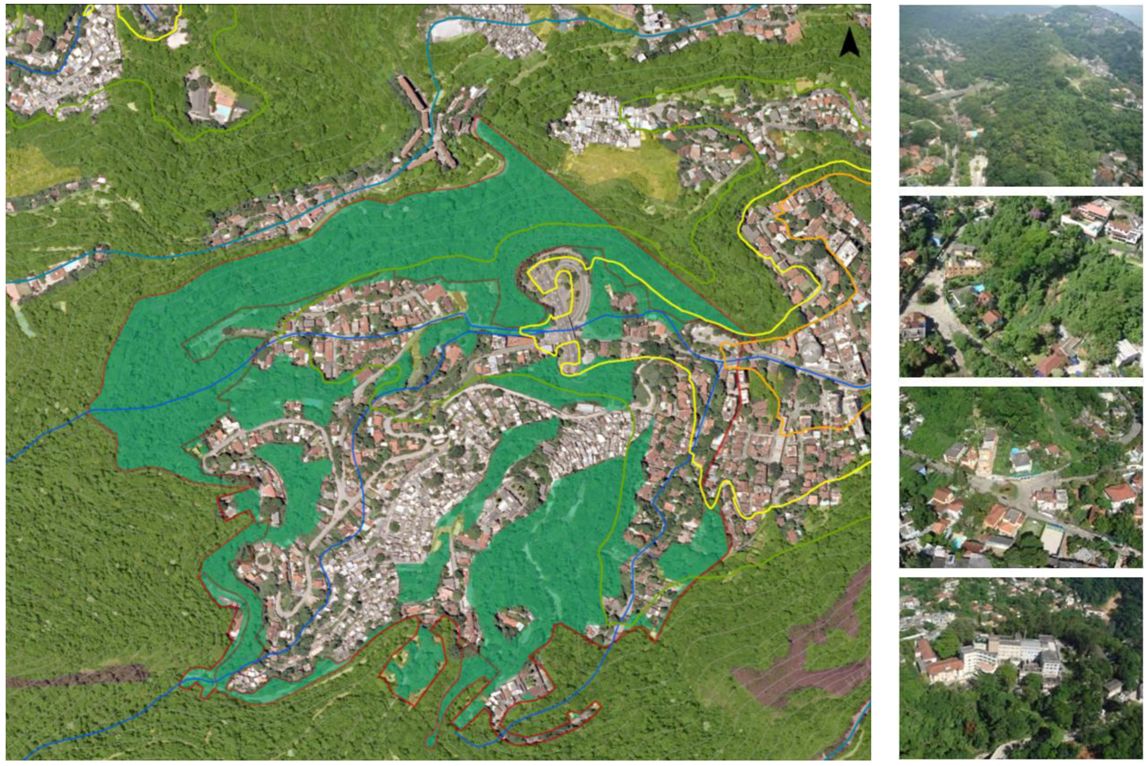
4. Discussion
- 1. Landscape structure and function: Characteristic features of the occupation of hillsides in Rio de Janeiro include the spread of occupation from the valley bottoms and the main lines of natural drainage, which act as vectors to induce urban occupation and tend to concentrate processes of consolidation and vertical growth of occupation.
- 2. Pattern-processes relationship: The Carioca watershed’s formal and informal settlements have a relationship of contiguity, connected by the river, the winding roads and the local labor market dynamics that link them. The strategy designed by the government to minimize the conflicts generated by social polarization that characterizes the occupation of the slopes of the city of Rio de Janeiro lies in the release of legal limits and constraints set out in legislation.
- 3. Land ownership and illegality: Most of the area occupied by the studied favelas was originally privately owned. The emergence of the first nuclei of formal and informal settlements was simultaneous and spawned interdependent relationships. The first urban settlements on the hillsides had their origin in the decline of agriculture and the opening of roads and streets on the slopes. The first favelas nuclei were spurred by early landowners, the Catholic Church, and other institutions, both public and private. Currently, most of the urban land located on Rio de Janeiro’s slopes is in the hands of a few owners, essentially constituting large estates. The deeds of some of these tracts are not even registered at the City Hall.
- 4. Open spaces: The open spaces on the slopes serve multiple functions. They act as vegetated corridors that penetrate and cross the occupied areas, providing ecological connection to the rainforest and helping to maintain a degree of carrying and adaptive capacity in mountainous areas. These spaces include the forest reserves, the connected back bounds of residential plots, the forested open spaces located along the edges of the slums, the small social spaces nested deep within each neighborhood, and the open spaces located along the valley bottoms—all forms of open spaces in the upper Carioca—deserve special attention, care and protection due to their multifunctional nature. Yet the neglect, privatization, and incremental replacement of open spaces with built form continue to occur in both formal and informal settlements.
- 5. Regulation: Parameters set by city legislation so far (whether for high or low income strata settlements) are insufficient to match the complex geomorphology of the mountainous areas of the city. Grounded in previous works [65,66,67,68,69,70], we argued the need to associate altimetry, slope (already applied in other Brazilian cities urban planning legislation), shape of slope, and the configuration, distribution and management of open spaces and native vegetation as additional parameters for sustainable landscape planning. As demonstrated by previous local surveys [66,67,68,69], it is not just the steeper areas that are particularly susceptible to landslides. Thus, it is imperative to establish the watershed as an urban planning unit for the purpose of formulating an integrated zoning that would restrict cut and fill on 15° (approximately 25%) and greater slopes, and prohibit new occupations in between 15° and 20° slopes in concave/convergent areas and above 35° in convex/divergent area (see Figure 11).

5. Conclusions
- ■ investigating the landscape through complementary scales of time and space;
- ■ understanding the influence of cultural perceptions of nature on landscape management;
- ■ identifying the connections and dissociations between ecological and cultural dimensions;
- ■ incorporating the visions and roles of different agents of landscape transformation;
- ■ acknowledging the role of open spaces in structuring buffering capacity, restoring resilienceand building on landscape sustainability.
Acknowledgments
Conflict of Interest
References
- Gould, S.J. Bully for Brontosaurus: Reflections in Natural History; W.W. Norton & Company: New York, NY, USA, 1991. [Google Scholar]
- Schlee, M.B. Landscape Change Along the Carioca River, Rio de Janeiro, Brazil. Master`s Thesis, The Pennsylvania State University, University Park, PA, USA, 2002. [Google Scholar]
- Schlee, M.B. A Ocupação das Encostas do Rio de Janeiro: Morfologia, Legislação e Processos Sócio-Ambientais. Ph.D. Dissertation, Federal University of Rio de Janeiro, Rio de Janeiro, Brazil, 2011. [Google Scholar]
- Brundtland, G.H.; Khalid, M. Common Future; Report of the World Commission on Environment and Development, United Nations Document A/42/427. Oxford University Press: Oxford, UK, 1987. [Google Scholar]
- Arrow, K.; Bolin, B.; Costanza, R.; Dasgupta, P.; Folke, C.; Holling, C.S.; Jansson, B.-O.; Levin, S.; Mdler, K.-G.; Perrings, C.; Pimentel, D. Economic growth, carrying capacity, and the environment. Science 1995, 268, 520–521. [Google Scholar]
- Acselrad, H. Sustainability and Territory: Meaningful Practices and Material Transformations. In Sustainability and the Social Sciences: A Cross-Disciplinary Approach to Integrating Environmental Considerations into Theoretical Reorientation; Becker, E., Jahn, T., Eds.; ZED Books: London, UK, 1999; pp. 37–57. [Google Scholar]
- Ehrlich, P.; Kareiva, P.M.; Daily, G.C. Securing natural capital and expanding equity to rescale civilization. Nature 2012, 486, 68–73. [Google Scholar]
- Folke, C. Resilience: The emergence of a perspective for social-ecological systems analyses. Glob. Environ. Change 2006, 16, 253–267. [Google Scholar] [CrossRef]
- Holdren, J.P. Science and technology for sustainable well-being. Science 2008, 319, 424–434. [Google Scholar] [CrossRef]
- Leitao, A.B.; Ahern, J. Applying landscape ecological concepts and metrics in sustainable landscape planning. Landsc. Urban Plan. 2002, 59, 65–73. [Google Scholar] [CrossRef]
- Johnson, B.R.; Hill, K. Introduction: Toward Landscape Realism. In Ecology and Design: Frameworks for Learning; Johnson, B.R., Hill, K., Eds.; Island Press: Washington, DC, USA, 2002; pp. 1–28. [Google Scholar]
- McHarg, I.L. Design with Nature; The Natural History Press: New York, NY, USA, 1969. [Google Scholar]
- Forman, R.T.; Godron, M. Landscape Ecology; John Wiley & Sons: New York, NY, USA, 1986. [Google Scholar]
- Forman, R.T. Land Mosaics: The Ecology of Landscapes and Regions; Cambridge University Press: Cambridge, MA, USA; p. 1995.
- Turner, M. Landscape ecology: The effect of pattern on processes. Annu. Rev. Ecol. Syst. 1989, 20, 171–191. [Google Scholar]
- Quantitative Methods in Landscape Ecology; Turner, M.G.; Gardner, R.H. (Eds.) Springer-Verlag: New York, NY, USA, 1991.
- Zonneveld, I.S. Land Ecology: An Introduction to Landscape Ecology as a Base for Land Evaluation, Land Management and Conservation; SPB Publishing: Amsterdam, The Netherlands, 1995. [Google Scholar]
- Environmental Protection Agency, Watershed Approach Framework; Environmental Protection Agency, Office of Water: Washington, DC, USA, 1996.
- Environmental Protection Agency, Volunteer Stream Monitoring: A Methods Manual; Document EPA #841-B-97-003; Environmental Protection Agency, Office of Water: Washington, DC, USA, 1997.
- Environmental Protection Agency, Urbanization and Streams: Studies of Hydrologic Impacts. Non-point Source Pollution Control Program; Environmental Protection Agency, Office of Water: Washington, DC, USA, 1998.
- Environmental Protection Agency, Rapid Bioassessment Protocols for Use in Streams and Wadeable Rivers: Periphyton, Benthic Macroinvertebrates, and Fish, 2nd edEnvironmental Protection Agency, Office of Water: Washington, DC, USA, 2000.
- Ndubisi, F. Ecological Planning: A Historical and Comparative Synthesis; Johns Hopkins University Press: Baltimore, MD, USA, 2002. [Google Scholar]
- Hough, M. Cities and Natural Process: A Basis for Sustainability; Routledge: New York, NY, USA, 1995. [Google Scholar]
- Nassauer, J.I. Placing Nature: Culture and Landscape Ecology; Island Press: Washington, DC, USA, 1998. [Google Scholar]
- Ahern, J. Spatial Concepts, Planning, Strategies and Future Scenarios: A Framework Method for Integrating Landscape Ecology and Landscape Planning. In Landscape Ecological Analysis: Issues and Applications; Klopatek, J., Gardner, R., Eds.; Springer: New York, NY, USA, 1999; pp. 175–201. [Google Scholar]
- Moudon, A.V.; Hubner, M. Monitoring Land Supply with Geographic Information Systems Theory, Practice, and Parcel-Based Approaches; Wiley, John & Sons: New York, NY, USA, 2000. [Google Scholar]
- Holling, C.S. Understanding the complexity of economic, ecological, and social systems. Ecosystems 2001, 4, 390–405. [Google Scholar] [CrossRef]
- Turner, M.G.; Gardner, R.H.; ONeill, R.V. Landscape Ecology in Theory and Practice; Springer-Verlag: New York, NY, USA, 2001. [Google Scholar]
- Planning and Design for Sustainable and Resilient Cities: Theories, Strategies and Best Practices for Green Infrastructure. In Water-Centric Sustainable Communities; Novotny, V.; Ahern, J.; Brown, P. (Eds.) John Wiley and Sons: Hoboken, NJ, USA, 2010; pp. 135–176.
- Ahern, J. From fail-safe to safe-to-fail: Sustainability and resilience in the new urban world. Landsc. Urban Plan. 2011, 100, 341–343. [Google Scholar] [CrossRef]
- Odum, E.; Brewer, R.; Barrett, G. Fundamentals of Ecology, 5th ed; Cengage Learning: Stamford, CT, USA, 2004. [Google Scholar]
- Kostof, S. The City Shaped: Urban Patterns and Meanings through History; Thames & Hudson: London, UK, 1991. [Google Scholar]
- Lamas, J.M. MorfologiaUrbana e o Desenho da Cidade; Fundação Calouste Gulbekian: Lisboa, Portugal, 1992. [Google Scholar]
- Panerai, P.; Depaule, J.; Demorgon, M. Analyse Urbaine; Editions Parenthèses: Marseille, France, 1999. [Google Scholar]
- Weins, J. Toward an Unified Landscape Ecology. In Issues and Perspectives in Landscape Ecology; Weins, J., Moss, M., Eds.; Cambridge University Press: Cambridge, MA, USA, 2005. [Google Scholar]
- Wang, S.-H.; Huang, S.-L.; Budd, W. Resilience analysis of the interaction of between typhoons and land use change. Landsc. Urban Plan. 2012, 106, 303–315. [Google Scholar] [CrossRef]
- United States Department of Agriculture, Stream Visual Assessment Protocol; Technical Note 99-1. National Water and Climate Center, Natural Resources Conservation Service: Washington, DC, USA, 1998.
- Petersen, R.C. RCE: A riparian, channel, and environmental inventory for streams in the agricultural landscape. Freshw. Biol. 1992, 27, 295–306. [Google Scholar] [CrossRef]
- GEOHECO-UFRJ/SMAC-PCRJ, Estudos de Qualidade Ambiental do Geoecossistema do Maciço da Tijuca: Subsídios à Regulamentação da APARU do Alto da Boa Vista; PCRJ/SMAC: Rio de Janeiro, Brazil, 2000.
- Brazil, Instituto Brasileiro de Geografia e Estatistica, Census 1991, 2000 and 2010. Available online: http://www.ibge.gov.br/home/download/estatistica.shtm (accessed on 20 May 2011).
- Rio de Janeiro, Instituto Municipal de Urbanismo Pereira Passos, Armazem de Dados, Estatisticas Municipais, Caracteristicas Gerais, tables 2972, 2917 and 1754. Available online: http://www.armazemdedados.rio.rj.gov.br/ (accessed on 6 October 2010).
- Riley, A.L. Restoring Streams in Cities: A Guide for Planners, Policymakers and Citizens; Island Press: Washington, DC, USA, 1998. [Google Scholar]
- Rosgen, D. Applied Stream Morphology; Wildland Hydrology: Pagosa Springs, CA, USA, 1996. [Google Scholar]
- Newbury, R.W.; Gaboury, M.N. Stream Analysis and Fish Habitat Design: A Field Manual; Newbury Hydraulics Ltd.: Gibsons, BC, Canada, 1993. [Google Scholar]
- Leopold, L.B.; Wolman, M.G.; Miller, J.P. Fluvial Processes in Geomorphology; W.H. Freeman and Company: San Francisco, CA, USA, 1964. [Google Scholar]
- Coelho Netto, A.L. A Geoecologia e a Arquitetura da Paisagem do Rio de Janeiro no Século XXI: Da Degradação à Reabilitação Funcional da Cidade e da Floresta Atlântica Remanescente. In Águas Urbanas: A Regeneração Ambiental como Campo Disciplinar Integrado; Tangari, V., Schlee, M.B., Andrade, R., Dias, M.A., Eds.; PROARQ-FAU/UFRJ, ETU/UFRJ, ABAP-RIO, IPP/PCRJ: Rio de Janeiro, Brazil, 2007. [Google Scholar]
- Coelho Netto, A.L. Ecossistemas de Encostas. Protocolo do Rio/Estudos e Pesquisas—Seminário Rio: Próximos 100 anos, 2007. Available online: http://www.rio.rj.gov.br/ipp/ (accessed on 20 May 2011).
- Coelho Netto, A.L. Catastrophic Landscape Evolution in a Humid Region (SE Brasil): Inheritances from Tectonic, Climatic and Land Use Induced Changes. In Supl. Geogr. Fis. Dinam. Quat. Vol. III; Fourth International Conference on Geomorphology: Bologna, Italy, 1999; pp. 21–48. [Google Scholar]
- Coelho Netto, A.L. Surface Hydrology and Soil Erosion in a Tropical Mountainous Rainforest Drainage Basin, Rio de Janeiro. Ph.D. Dissertation, Katholieke Universiteit Leuven, Leuven, Belgium, 1985. [Google Scholar]
- Observatório das Metrópoles/IPPUR/FASE. Análise das regiões Metropolitanas do Brasil. Como Andam as metro Poles Brasileiras. Available online: http://www.observatoriodasmetropoles.ufrj.br/como_anda/ (accessed on 7 August 2010).
- Brazil, Instituto Brasileiro de Geografia e Estatistica. Available online: http://www.ibge.gov.br/cidadesat/topwindow.htm?1/ (accessed on 20 May 2011).
- Coutinho, B.H. Domínios Geo-Hidroecológicos e Padrões de Fragmentação da Mata Atlântica—Bacia do Macacu. Ph.D. Dissertation, Geosciences Institute/UFRJ, Rio de Janeiro, Brazil, 2001. [Google Scholar]
- Schlee, M.B.; Coelho Netto, A.L.; Tamminga, K. MapeamentoAmbiental e Paisagístico de BaciasHidrográficasUrbanas: Estudo de Casodo Rio Carioca. In Rios e Paisagem Urbana em Cidades Brasileiras; Costa, L., Ed.; Viana & Mosley: Rio de Janeiro, Brazil, 2006; pp. 33–55. [Google Scholar]
- Cavalcanti, N. Rio de Janeiro, Centro Histórico 1808–1998. Marcos da Colônia; Dresdner Bank: Rio de Janeiro, Brasil, 1998. [Google Scholar]
- Rezende, R. Memórias e Curiosidades do Bairro de Laranjeiras; João Fortes Engenharia: Rio de Janeiro, Brazil, 1999. [Google Scholar]
- Abreu, M.A. CidadeBrasileira: 1870–1930. In Urbanização e Cidades: Perspectivas Geográficas; Sposito, M.E.B., Ed.; UNESP/GASPPERR: Presidente Prudente, Brazil, 2001. [Google Scholar]
- Bohadana, E.B. Guararapes: Uma História de Encontros e Desencontros. Master’s Thesis, Programa de Pós-Graduação em Engenharia/COPPE/UFRJ, Rio de Janeiro, Brazil, 1983. [Google Scholar]
- Dantas, A.C.; Senra, K. Diagnósticodas Comunidades Guararapes, Vila Cândido e Cerro-Corá; Teixeira de Freitas/Programa Favela-Bairro PCRJ/SMH: Rio de Janeiro, Brazil, 1994. [Google Scholar]
- Silva, J.M.; Tangari, V.R. EnsinarCegos a “Ver”: A Crise Urbana Do Brasil. In Anaisdo XVII Congresso Brasileiro de Arquitetos; IAB/RJ: Rio de Janeiro, Brazil, 2003. [Google Scholar]
- Santos, C.N.F. O queTransforma e o que É Transformado. In Desenho Urbano; Turkienicz, B., Ed.; Cadernos Brasileiros de Arquitetura, Projeto Editores Associados: São Paulo, Brazil, 1984. [Google Scholar]
- Cardoso, A.L. O Programa Favela-Bairro—Uma Avaliacao. In Anaisdo Seminario de Avaliacao de Projetos IPT Habitacao e Meio Ambiente Assentamentos Urbanos Precarios; Paginas e Letras Editora e Grafica LTDA: Sao Paulo, Brazil, 2002; pp. 37–50. [Google Scholar]
- Andrade, L.S. Espaços Publicos e Favelas: Uma Analise da Dimensão Publica dos Espaços Coletivos Não-Edificados da Rocinha. Ph.D. Dissertation, PROURB/FAU/UFRJ, Rio de Janeiro, Brazil, 2002. [Google Scholar]
- Farias, J.S. A Forma da Informalidade: Uma Análise da Morfologia Urbana da Rocinha. Ph.D. Dissertation, PROURB/FAU/UFRJ, Rio de Janeiro, Brazil, 2009. [Google Scholar]
- Coelho, G.N. Brincadeiras Infantis nos Espaços Livres da Rocinha. Master’s Thesis, PROARQ/FAU/UFRJ, Rio de Janeiro, Brazil, 2004. [Google Scholar]
- Ruhe, R.V. Geomorphology: Geomorphic Processes and Surficial Geology; Houghton Mifflin Company: Boston, MA, USA, 1975. [Google Scholar]
- Avelar, A.S. Iniciação e Desenvolvimento de Fluxos Detríticos em Encosta: Ensaios Triaxiais de Choque e em Caixa Experimental Abordando o Caso do Soberbo. Ph.D. Dissertation, COPPE/UFRJ, Rio de Janeiro, Brazil, 2003. [Google Scholar]
- Avelar, A.S. Investigação Histórica e Geotécnica do Movimento de Massa do Soberbo. Master’s Thesis, COPPE-UFRJ, Rio de Janeiro, Brazil, 1996. [Google Scholar]
- Avelar, A.S.; Lacerda, W.A. Causas iniciais do movimento de massa da encosta do Soberbo, Rio de Janeiro, Brasil. In 2a Conferência Brasileira sobre Estabilidade de Encostas; ABMS, ABGE, ISSMGE: Rio de Janeiro, Brazil, 1997; pp. 3–12. [Google Scholar]
- Coelho Netto, A.L.; Avelar, A.; Fernandes, M.; Lacerda, W. Landslide susceptibility in a mountainous geoecosystem, Tijuca Massif, Rio de Janeiro: The role of morphometric subdivision of the terrain. Geomorphology 2007, 7, 120–131. [Google Scholar]
- Valeriano, M. Topodata: Guia de Utilização de Dados Geomorfológicos Locais; INPE: São José dos Campos, Brazil, 2008. [Google Scholar]
- Soares, M.L.G. Floresta Carioca: An Interface Urbano-Florestal do Parque Nacional da Tijuca. Ph.D. Dissertation, IPPUR/UFRJ, Rio de Janeiro, Brazil, 2006. [Google Scholar]
- Abreu, M.A. Reconstruindo uma história esquecida: Origem e expansão inicial das favelas do Rio de Janeiro. Espaço e Debates 1994, 14, 34–46. [Google Scholar]
- Pechman, R. O UrbanoFora do Lugar? Transferências e Traduções das IdéiasUrbanísticasnosAnos 20. In Cidade, Povo e Nação. Gênese do Urbanismo Moderno; Ribeiro, L.C.Q., Pechman, R., Eds.; Civilização Brasileira: Rio de Janeiro, Brasil, 1996. [Google Scholar]
- National Research Council Board on Sustainable Development, Our Common Journey: A Transition toward Sustainability; National Academy Press: Washington, DC, USA, 1999.
© 2012 by the authors; licensee MDPI, Basel, Switzerland. This article is an open-access article distributed under the terms and conditions of the Creative Commons Attribution license (http://creativecommons.org/licenses/by/3.0/).
Share and Cite
Schlee, M.B.; Tamminga, K.R.; Tangari, V.R. A Method for Gauging Landscape Change as a Prelude to Urban Watershed Regeneration: The Case of the Carioca River, Rio de Janeiro. Sustainability 2012, 4, 2054-2098. https://doi.org/10.3390/su4092054
Schlee MB, Tamminga KR, Tangari VR. A Method for Gauging Landscape Change as a Prelude to Urban Watershed Regeneration: The Case of the Carioca River, Rio de Janeiro. Sustainability. 2012; 4(9):2054-2098. https://doi.org/10.3390/su4092054
Chicago/Turabian StyleSchlee, Mônica Bahia, Kenneth R. Tamminga, and Vera Regina Tangari. 2012. "A Method for Gauging Landscape Change as a Prelude to Urban Watershed Regeneration: The Case of the Carioca River, Rio de Janeiro" Sustainability 4, no. 9: 2054-2098. https://doi.org/10.3390/su4092054





